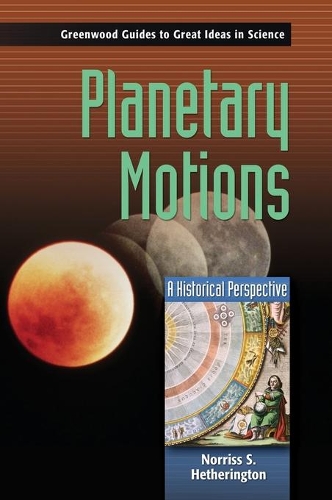
Planetary Motions: A Historical Perspective
(Hardback)
Publishing Details
Planetary Motions: A Historical Perspective
By (Author) Norriss S. Hetherington
Bloomsbury Publishing PLC
Greenwood Press
30th July 2006
United States
Classifications
General
Non Fiction
Solar system: the Sun and planets
523.4
Physical Properties
Hardback
248
Width 178mm, Height 254mm
680g
Description
Students in an introductory physics class learn a variety of different, and seemingly unconnected, concepts. Gravity, the laws of motion, forces and fields, the mathematical nature of the science - all of these are ideas that play a central role in understanding physics. And one thing that connects all of these physical concepts is the impetus the great scientists of the past had to develop them - the desire to understand the motion of the planets of the solar system. This desire led to the revolutionary work of Copernicus and Galileo, Kepler and Newton. And their work forever altered how science is practiced and understood.
Reviews
Hetherington covers the history of attempts to understand planetary motion, starting with the Babylonians, continuing through Plato and Ptolemy, and ending with Copernicus and Newton. He has written extensively on this subject and is the director of the Institute for the History of Astronomy at Berkeley. His expertise is evident in his clear, insightful overview of astronomy and the personalities of the people who pursued it, but what is unique is the ease with which he connects science to the cultures in which it was practiced. The index includes Bach, Julius Caesar, Dionysius, John Donne, Frederick II, Goethe, Alexander Hamilton, Thomas Jefferson, Mohammed, Moliere (Moliere) , Mozart, Voltaire, and even God. The writing is authoritative but also accessible and humorous: the conflict between Descartes' and Newton's understanding of gravity is summarized by the statement that In Paris everything was explained by a pressure that nobody understood; in London everything was explained by an attraction that nobody understood either. A thorough, engaging study. Highly recommended. General readers; lower- and upper-division undergraduates. * Choice *
Focusing on classical planetary mechanics from the period from Plato through Newton, this book is a feast for those interested in the history of astronomy.Here.[i]s a clear and concise exposition of the thinking of some of the greatest minds in the history of science on the queen of all disciplines.Throughout the book are fascinating boxes and sidebars on social and humanistic issues related to the astronomy of the time, and the author has also included useful instrumental exercises by which the reader can delve into the subject further.[t]his is an exceptional text that will prove useful in introductory and intermediate-level history-of-science courses.[I] recommend the book highly to anyone who simply is curious about how we have come to know the structure of our solar system and the place of humankind in the universe. * Science Books & Films *
Director of the Institute to the History of Astronomy, Hetherington begins by reviewing the history of science in general to provide a framework. Then he traces the evolution of modern ideas about how planets move from Babylonian planetary astronomy to the Newtonian revolution. Among the stages are Plato, eccentricities and epicycles, Ptolemy, Islamic planetary astronomy, and the Copernican revolution. No knowledge of astronomy is assumed. * SciTech Book News *
Now and again a resource comes along that provides a new look at an old, even ancient, topic. In this book, teachers of higher-level, secondary physics classes, along with their students, can discover a new perspective on the historical development of theories involving planetary motion. The author approaches the physics concepts of gravity, laws of motion, forces, and fields, among others, through its explanation of how great scientists of the past actually developed them.This books helps us understand the history that has brought us to our current physics practice, understanding, and instruction. As a resource for teachers or required reading for students, this book can help to provide a unique foundation for future physics classes. Through a detailed timeline and bibliography that supports its contents with research, its approach to the presentation of the material will truly keep readers involved. * NSTA Recommends National Science Teachers Association *
Author Bio
Norriss S. Hetherington is the director of the Institute for the History of Astronomy and a Visiting Scholar with the Office of the History of Science and Technology at the University of California, Berkeley. He has written extensively on the history of astronomy and cosmology, and has edited Encyclopedia of Cosmology: Historical, Philosophical, and Scientific Foundations of Modern Cosmology, and Cosmology: Historical, Literary, Philosophical, Religious, and Scientific Perspectives.
